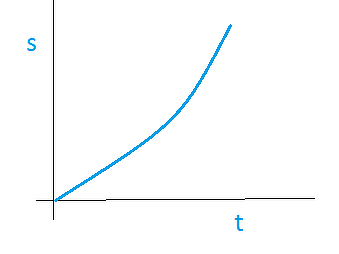NCERT Solutions for Class 9 Science Chapter 7 - Motion
| Table of contents |

|
| Page No. 74 |

|
| Page No. 76 |

|
| Page No. 77 |

|
| Page No. 81 |

|
| Page No. 82 |

|
| Page No. 83 |

|
| Page No. 85 |

|
| Page No. 86 |

|
Page No. 74
Q1. An object has moved through a distance. Can it have zero displacements? If yes, support your answer with an example.
Ans: Yes, an object can have zero displacements even if it has moved through a distance.
Example: If an athlete runs around a circular path of radius 'r' and comes back to the initial point, then distance covered = 2πr, displacement = zero.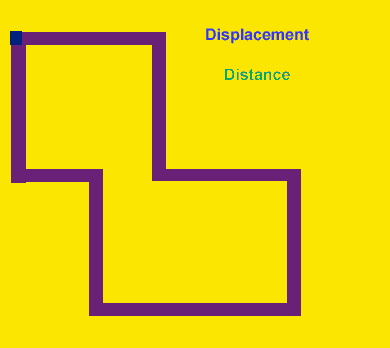
Q2. A farmer moves along the boundary of a square field of side 10 m in the 40s. What will be the magnitude of displacement of the farmer at the end of 2 minutes 20 seconds from his initial position?
Ans: Given,
Side of the given square field = 10m
Hence, the perimeter of a square = 40 m
Time taken by the farmer to cover the boundary of 40 m = 40 s
So, in 1 s, the farmer covers a distance of 1 m
Now,
Distance covered by the farmer in 2 min 20 sec = 1 x 140 = 140 m
So, the total number of rotations taken by the farmer to cover a distance of 140 m = total distance/perimeter = 3.5
At this point, let us say the farmer is at point B from the origin O
Therefore, from Pythagoras theorem, the displacement s = √(102+102) = 10√2 = 14.14 m
Q3. Which of the following is true for displacement?
(a) It cannot be zero.
(b) Its magnitude is greater than the distance travelled by the object.
Ans:
(a) False; because the displacement is zero if an object returns to its initial position after completing the trip.
(b) False; the displacement always has equal or less magnitude than the distance travelled.
Page No. 76
Q1. Distinguish between speed and velocity.
Ans: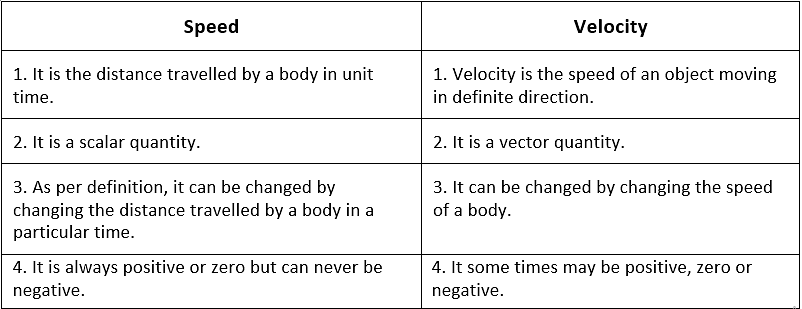
Q2. Under what condition(s) is the magnitude of the average velocity of an object equal to its average speed?
Ans: Average speed measures the total distance covered over a specific time period, while average velocity refers to the total displacement during that same time. The magnitudes of average speed and average velocity will be equal when the total distance traveled matches the displacement.
Q3. What does the odometer of an automobile measure?
Ans: An odometer, also known as an odograph, is a device that calculates the distance an automobile has travelled by measuring the circumference of the wheel as it rotates.
Q4. What does the path of an object look like when it is in uniform motion?
Ans: The path of the object will be a straight line at the instant of measurement when it is in uniform motion.
Q5. During an experiment, a signal from a spaceship reached the ground station in five minutes. What was the distance of the spaceship from the ground station? The signal travels at the speed of light, which is 3 × 108 ms-1.
Ans: Speed of signal = 3 × 108 ms-1
Time in which signal reaches ground = 5 min = 5 × 60 = 300 s
Distance of spaceship from the ground level = speed × time = 3 × 108 × 300 = 9 × 1010 m
Page No. 77
Q1. When will you say a body is in
(i) Uniform acceleration (ii) Non-uniform acceleration?
Ans:
(i) If an object travels in a straight line and its velocity increases or decreases by equal amounts in equal intervals of time, then the body is said to be in uniform acceleration.
Example: The motion of a freely falling body.
(ii) If an object travels in a straight line and its velocity changes by unequal amounts in equal intervals of time, then the body is said to be in non-uniform acceleration.
Example: If a car is travelling along a straight road and passes through a crowd, suffers an unequal change in velocity, in equal intervals of time.
Q2. A bus decreases its speed from 80 km h−1 to 60 km h−1 in 5 s. Find the acceleration of the bus.
Ans: We know, 1km = 1000m ; 1hr = 3600s
Given the initial speed of the bus,u = 80 kmh-1 ms-1
ms-1
The final speed of the bus,v = 60 kmh-1=  ms-1
ms-1
Time is taken, t= 5s
We know, v = u+at
 = -1.11 ms-2
= -1.11 ms-2
The negative sign implies retardation.
Therefore, the acceleration of the bus is -1.11 ms-2
Or, the retardation (deceleration) of the bus is 1.11 ms-2
Q3. A train starting from a railway station and moving with uniform acceleration attains a speed of 40 km/h-1 in 10 minutes. Find its acceleration.
Ans: Given,
Initial velocity, u = 0 km /h
Final velocity, v = 40 km/h =40 × ( 5/ 18) = 11.11 m/s
Time, t = 10 min = 10 × 60 = 600 sec
Acceleration, a = ?
Consider the formula, v = u + at
⇒ 11.11 = 0 + a × 600
⇒ 11.11 = 600 a
⇒ a = 11.11/600 = 0.0185 m/s2
Page No. 81
Q1. What is the nature of the distance-time graphs for uniform and non-uniform motion of an object?
Ans:
- When the motion is uniform, the distance-time graph is a straight line with a slope.

- When the motion is non-uniform, the distance-time graph is not a straight line. It can be any curve.

Q2. What can you say about the motion of an object whose distance-time graph is a straight line parallel to the time axis?
Ans: If the distance-time graph is a straight line parallel to the time axis, the body is at rest.
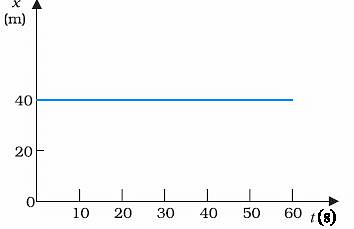
Q3. What can you say about the motion of an object if its speed-time graph is a straight line parallel to the time axis?
Ans: If the speed-time graph is a straight line parallel to the time axis, the object is moving uniformly.

Q4. What is the quantity which is measured by the area occupied below the velocity-time graph?
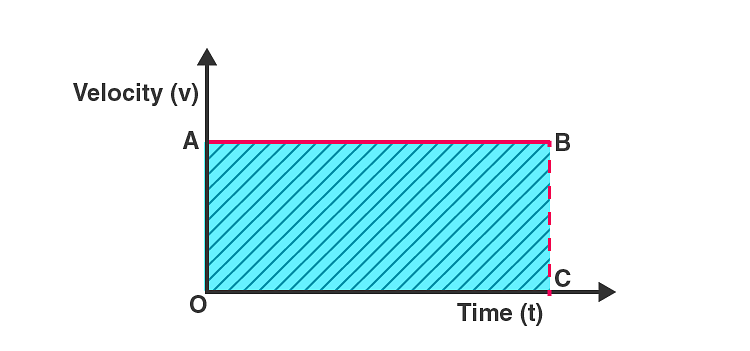
Ans: The area beneath the velocity-time graph corresponds to the area of the rectangle OABC, calculated as OA multiplied by OC. Here, OA represents the object's velocity, and OC indicates time. Thus, the shaded area can be expressed as:
The area under the velocity-time graph = velocity × time.
By substituting the value of velocity as displacement divided by time into this equation, we find that the area under the velocity-time graph represents the total displacement of the object.
Page No. 82
Q1. A bus starting from rest moves with a uniform acceleration of 0.1 m s-2 for 2 minutes. Find
(a) the speed acquired, (b) the distance travelled.
Ans: Given,
Initial velocity, u = 0 ms-1
Acceleration, a = 0.1 ms-2
Time, t = 2 min = 120 s
(a) Speed, v = u + at = 0 + 0.1 x 120 = 12 ms-1
(b) Distance, s  = 720 m
= 720 m
The speed acquired is 12 ms-1 and the total distance travelled is 720 m.
Q2. A train is travelling at a speed of 90 km/h-1. Brakes are applied so as to produce a uniform acceleration of 0.5 ms-2. Find how far the train will go before it is brought to rest.
Ans: Given the initial speed of the train, u= 90 km/h = 25 m/s
Final speed of the train, v = 0 m/s (finally the train comes to rest)
Acceleration = - 0.5 m s-2
According to the third equation of motion:
v2 = u2 + 2as (where s is the distance covered by the train)
⇒ (0)2 = (25)2 + 2 (- 0.5) s
⇒
The train will cover a distance of 625 m at an acceleration of -0.5ms-2 before it comes to rest.
Q3. A trolley, while going down an inclined plane, has an acceleration of 2 cm/s-2. What will be its velocity 3 s after the start?
Ans: Initial Velocity of trolley, u = 0 cms-1; Acceleration, a = 2 cms-2; Time, t = 3 s
We know that final velocity, v = u + at = 0 + 2 x 3 cms-1
Therefore, The velocity of the train after 3 seconds = 6 cms-1
Page No. 83
Q4. A racing car has a uniform acceleration of 4 ms2. What distance will it cover in 10 s after the start?
Ans: Initial Velocity of the car, u = 0 ms-1; Acceleration, a = 4 m s-2; Time, t = 10 s
We know Distance, s = ut + (1/2) at2
Therefore, Distance covered by car in 10 second = 0 × 10 + (1/2) × 4 × 102 = (1/2) × 400 = 200 m
Q5. A stone is thrown in a vertically upward direction with a velocity of 5 m/s-1. If the acceleration of the stone during its motion is 10 m/s-2 in the downward direction, what will be the height attained by the stone and how much time will it take to reach there?
Ans: Given,
The initial velocity of stone, u = 5 ms-1
Downward or negative acceleration, a = 10 ms-2
We know that: 2as = v2- u2
⇒ 0 = (5)2 + 2 x(-10) x s
⇒ 0 = 25 - 20s
⇒ s = 25/20 = 1.25 m
The height attained by stone, s = 1.25 m
We know that: v = u + at
⇒ 0 = 5 + (–10) × t
⇒ 0 = 5 − 10t
⇒ t = 5/10 = 0.5 s
Thus, the stone will attain a height of 1.25 m and the time taken to attain the height is 0.5 s.
Page No. 85
Q1. An athlete completes one round of a circular track of diameter 200 m in 40 s. What will be the distance covered and the displacement at the end of 2 minutes 20 s?
Ans: Here, the diameter of the circular track = 200 m.
The radius of the circular track, r = 100 m.
Let the athlete start moving from A, which is treated as a reference point.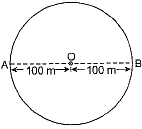 The distance covered by the athletes in 40 s = circumference of the circle = 2πr = 2π x 100 m = 200π m
The distance covered by the athletes in 40 s = circumference of the circle = 2πr = 2π x 100 m = 200π m
The distance traversed in one second = 200π/40 = 5π
Distance covered by athletes in 2 minutes and 20 seconds, i.e., 140 s
Number of complete rounds done by the athlete
Therefore, the final position of athletes at the end of 2 minutes and 20 seconds or just after three and a half rounds is B.
The displacement at the end of 2 minutes and 20 seconds = AB (diameter) = 200 m
Q2. Joseph jogs from one end A to the other end B of a straight 300 m road in 2 minutes 50 seconds and then turns around and jogs 100 m back to point C in another 1 minute. What are Joseph's average speeds and velocities in Jogging (a) from A to B and (b) from A to C?
Ans: Let Joseph jog from A to B and back to C as shown. (a) From A to B,
(a) From A to B,
distance covered = displacement = 300 m
Time taken = 2 minutes 30 s = 150 s
∴ Average speed = average velocity
(b) From A to C,
distance covered = 300 m + 100 m = 400 m
Total time = 150 s + 60 s = 210 s
Average speed = 400m/210s = 1.9 ms-1
However,
Displacement = 300 m - 100 m = 200 m, and Total time = 210 s
Average velocity = 200m/210s = 0.952 ms-1
Q3. Abdul while driving to school computes the average speed for his trip to be 20 kmh-1. On his return trip along the same route, there is less traffic and the average speed is 40 kmh-1. What is the average speed for Abdul's trip?
Ans: Let the distance between Abdul’s home and school be x.
Time taken by Abdul from home to school, 
Time taken by Abdul from school to home, 
Total time, t = t1 + t2
Total distance, s = x + x = 2x km
Average speed = 
Q4. A motorboat starting from rest on a lake accelerates in a straight line at a constant rate of 3.0 ms-2 for 8.0 s. How far does the boat travel during this time?
Ans: Given,
initial velocity of the boat = 0 m/s,
Acceleration = 3 m/s²
Time period = 8 seconds
From the second equation of motion,
Therefore, the motorboat covers a distance of 96 meters in 8 seconds.
Q5. A driver of a car travelling at 52 kmh-1 applies the brakes and accelerates uniformly in the opposite direction. The car stops in 5s. Another driver going at 3 kmh-1 in another car applies his brakes slowly and stops in 10 s. On the same graph paper, plot the speed versus time graphs for the two cars. Which of the two cars travelled farther after the brakes were applied?
Ans:

The total displacement of each car can be determined by calculating the area under the speed-time graph.
For the first car, the displacement is given by the area of triangle AOB:
Displacement of the first car= 1/2 ×OB×OA
Here, seconds and km/h, which converts to m/s. Therefore, the area of triangle AOB is:
For the second car, the displacement is represented by the area of triangle COD:
Here, seconds and km/h, which converts to m/s.
Thus, the area of triangle COD is
In conclusion, the first car is displaced by 36 meters, while the second car is displaced by 4.15 meters. Therefore, the first car, travelling at 52 km/h, moved farther after applying the brakes.
Q6. Figure below shows the distance-time graph of three objects A, B and C. Study the graph and answer the following questions :
(a) Which of the three is travelling the fastest?
(b) Are all three ever at the same point on the road?
(c) How far has C travelled when B passes A?
(d) How far has B travelled by the time it passes C?
 Ans:
Ans:
(a) since the slope of line B is the greatest, B is travelling at the fastest speed.
(b) since the three lines do not intersect at a single point, the three objects never meet at the same point on the road.
(c) since there are 7 unit areas of the graph between 0 and 4 on the Y axis, 1 graph unit equals 4/7 km.
Since the initial point of the object, C is 4 graph units away from the origin, Its initial distance from the origin is 4*(4/7)km = 16/7 km
When A passes B, the distance between the origin and C is 8km
Therefore, total distance travelled by C in this time = 8 – (16/7) km = 5.71 km
(d) the distance that object B has covered at the point where it passes C is equal to 9 graph units.
Therefore, the total distance travelled by B when it crosses C = 9*(4/7) = 5.14 km
Page No. 86
Q7. A ball is gently dropped from a height of 20 m. If its velocity increases uniformly at the rate of 10 ms-2, with what velocity will it strike the ground? After what time will it strike the ground?
Ans: Initial velocity of the ball, u = 0 (as it is dropped)
Height, h = 20 m, Acceleration, a = 10 ms-2,
Final velocity, v = ?, Time, t = ?
v2 = u2 + 2 as
Here, s = h
∴ v2 = 0 + 2 x 10 x 20 = 40
or Final velocity, v = 20 ms-1
The ball hits the ground with a velocity of 20 meters per second.
v = u + at
20 = 0 + 10t
∴ t = 20/10
or time, t = 2 s
Therefore, the ball reaches the ground after 2 seconds.
Q8. The speed-time graph for a car is shown in figure below.
(a) Find how far does the car travel in the first 4 seconds. Shade the area on the graph that represents the distance travelled by the car during the period.
(b) Which part of the graph represents uniform motion of the car?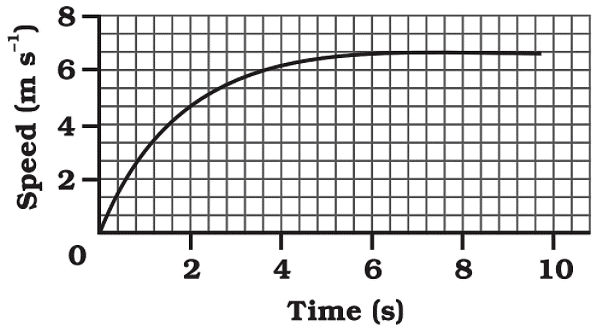
Ans:
(a)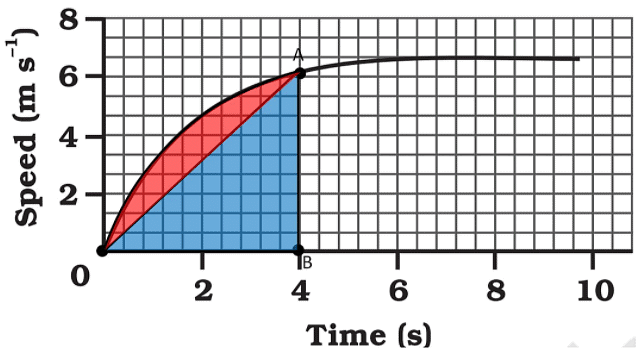
In the velocity-time graph,
Distance = Area of the v-t graph
Here we approximate the area using the area of the triangle,
Distance travelled = Area of triangle AOB
The shaded area, which is equal to 1/2 × 4 × 6 = 12 m represents the distance travelled by the car in the first 4 s.
(b)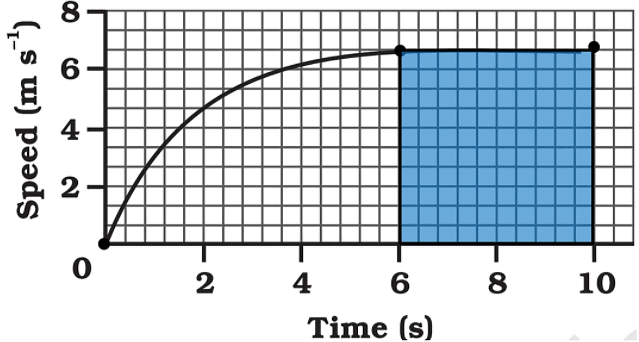 The part of the graph in red colour between times 6 s to 10 s represents the uniform motion of the car.
The part of the graph in red colour between times 6 s to 10 s represents the uniform motion of the car.
Q9. State which of the following situations are possible and give an example for each of these.
(a) An object with a constant acceleration but with zero velocity.
(b) An object moving in a certain direction with acceleration in the perpendicular direction.
(c) an object moving with acceleration but with uniform speed.
Ans:
(a) When an object is thrown upwards, it comes to a momentary rest at the highest point. Thus velocity is zero, but the acceleration due to the gravitational pull of the earth still acts upon it.
(b) In a uniform circular motion, the speed remains constant, but there is varying velocity as it changes its direction, so there always be acceleration which is given by centripetal force.
(c) When an object is thrown in the forward direction, then during its motion in the horizontal direction, the acceleration due to the gravity of the earth acts in the vertically downward direction.
Q10. An artificial satellite is moving in a circular orbit with a radius of 42250 km. Calculate its speed if it takes 24 hours to revolve around the earth.
Ans: Satellite completes one round in 24 hours
The radius of the orbit r42250 km
The circumference C of the orbit is given by:
C=2πr
Substituting the value of r:
C= 2×3.1416×42250 km
C≈ 265,571.6 km
Speed v = C/T
V= 265,571.6 km/24 hours
V ≈ 11, 065.48 km/h
|
87 videos|369 docs|67 tests
|
FAQs on NCERT Solutions for Class 9 Science Chapter 7 - Motion
| 1. What is the difference between speed and velocity ? |  |
| 2. How do you calculate the average speed of an object ? |  |
| 3. What are the laws of motion proposed by Newton ? |  |
| 4. What is uniform motion and non-uniform motion ? |  |
| 5. How does acceleration relate to motion ? |  |

|
Explore Courses for Class 9 exam
|

|

